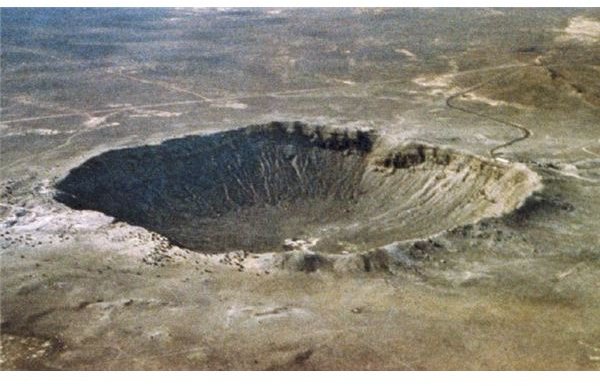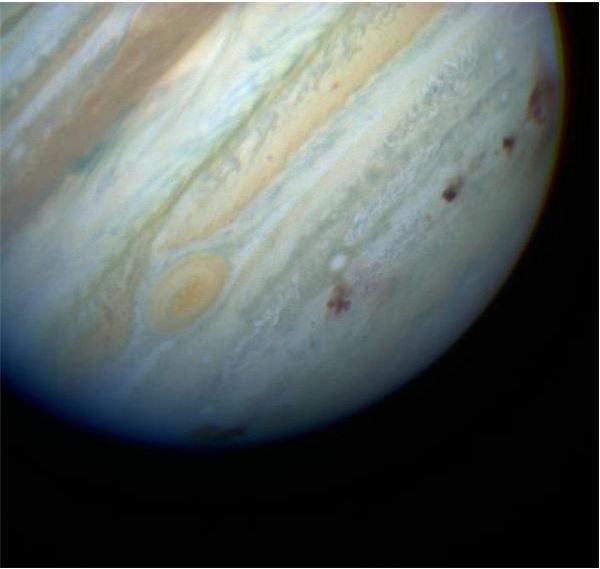Possible Scenarios if a Huge Meteor Fell on Earth: A Look at the Effects
The Sky is Falling the Sky is Falling!
This was a quote from one of the greatest minds of his time. Jefferson could not change his personal reality to include the possibility of something as strange as “stones falling from the sky”. He was not alone. At that same time, the French Academy of Science also poo-pooed the “idea of meteorites” as well. Saying that all of this could be explained by the quite terrestrial phenomenon of vulcanism, rocks being ejected from volcanoes. Their public statements sent a wave of museums tossing out, what were now, just worthless hunks of rock and iron. In great irony, the French Academy had to recant its position when in Europe a great meteor shower was viewed by unimpeachable witnesses.
Today we have no one doubting that, in deed, stones do fall from the sky. Yet there is a more serious issue that may have tremendously serious consequences. As Thomas Jefferson scoffed at the existence of meteorites, today many treat lightly the serious threat of a major meteor impact. Public awareness has been achieved largely through Hollywood movies. From the ridiculous Armageddon to the the mostly accurate and thoughtful Deep Impact films. But there you have it, it’s been put on the level of entertainment and not posed as a legitimate global threat. Serious writers like Arthur C. Clarke, Larry Niven, Jerry Pournelle, Grergory Benford and William Rosler have explored this threat using very realistic scenarios. Astronomers have done their best to sound the alarm to government officials and some steps have been taken.
What has Been Done by NASA?
In 1992 a Congressional study led to a NASA mandate to locate 90% of large NEO or Near Earth Objects. The survey was dubbed “Spaceguard”, taken from the fictional early warning system found in Clarke’s great book Rendezvous with Rama.
NASA has sponsored the Near-Earth Object Program. Its mission is to detect track and analyze the potentially dangerous asteroids and comets that could get close to the Earth. Its goal is to locate no less than 90% of the asteroids can comets that are a threat and are larger than 1 km in the next 10 years. This office is also the liaison between the public and the astronomical community if any dangerous chunks of ice or rock are found.
$4 million dollars is the annual budget for this very important program. The United States is currently the only country with a government sponsored program to detect potentially dangerous near Earth objects. The Planetary Society is sponsoring competitions to come up with good ideas on what to do with such a treat if it occurred. Any good ideas? Please forward them to Planetary.org.
Now if all this sound like, well, that no one is taking this as serious as it should be, you are right. $4 million is a drop in the bucket. It certainly is not commensurate with the threat level that such a disaster could inflict on Mother Earth.
Why is this?
The odds of a big impact tomorrow are exceedingly low. No one is going to get elected by making this a priority. The old argument goes, money could be better spent on more local problems. All true, but a wise man takes out insurance on even unlikely events as long as the price is affordable. Any NEO astronomer will tell you that the funding they get is really just pocket change. All those working on this problem can easily fit inside an average room.
Why should it be taken seriously?
There are two reasons. The first is that the impact of something large, something 1/2 a mile wide or bigger will have devastating effects. If something crosses our path that is really big, like a few miles wide, it would make the effects of all the wars ever fought put together, look like a summer tea party. The second reason, and the real important one, is that as a technological civilization we can do something about it. Given an early enough warning, we could actually launch a mission that would deflect the path of the celestial hammer coming down on our planet. How we could theoretically do that is the subject of a different article.
Shoemaker-Levy 9 hitting Jupiter
What would be the aftermath?
I have always loved a good disaster movie or book. There is no better a disaster theme for me than a huge meteor or comet heading our way. I have mentioned some of the best literature on this subject, above. I recommend you read them if this subject interests you. You will not only be entertained, but all three of those books will educate and enlighten you on the subject. We certainly got a good idea of the incredible energies that can be released when Jupiter was struck in 1994 by the shattered parts of Comet Shoemaker-Levy 9. Twenty one comet fragments hit Jupiter like a blast from a machine gun over a 6 day period. Scars the size of the Earth were visible on Jupiter’s surface. One of the impacts was estimated to have released the energy equivalent of 6,000,000 megatons of TNT. That would be like the entire nuclear arsenal of the world going off at one time, 600 times over. This served as a wake up call to astronomers, but apparently not to world governments. Some steps are being taken, but is it enough? Only time will tell.
If you are like me, you would like to know some of the scenarios for the Earth. It’s fun to make up scenarios, so here are a few.
Let’s set up a few consistent parameters to start off with. First lets say our impactor is a meteor. One big dense rock. Not Ice, and not Iron. We will say it’s a ocean strike for fun, in 1000 feet of water. Let’s also give the impact speed, and the angle of impact a realistic base setting of 17 km/s and 45 degrees. Let’s set ourselves in a spot away from these fake impacts we are going to stage. How about 400 miles away. Also let’s just talk about short term consequences.
Scenario One: Meteor Diameter 1000 ft.
What would you experience standing 400 miles away?
The projectile begins to breakup at an altitude of 54000 meters = 177,000 ft
The projectile reaches the ground in a broken condition. The mass of projectile strikes the surface at velocity 16.2 km/s = 10 miles/s
The I****mpact Energy is 5.82 x 1018 Joules = 1.39 x 103 Megatons.
The broken projectile fragments strike the ground in an ellipse of dimension 0.907 km by 0.641 km
The crater opened in the water has a diameter of 6.53 km = 4.06 miles
Final Crater Diameter on ocean floor: 2.04 km = 1.27 miles
The Fireball is below the horizon. There is no direct thermal radiation.
The major seismic shaking will arrive at approximately 129 seconds.
Richter Scale Magnitude: 5.5
Almost no solid ejecta reaches where you stand.
The Air Blas****t will arrive at approximately 1950 seconds.
Max Wind Velocity: 2.35 m/s = 5.25 mph
Sound Intensity: 60 dB (Loud as heavy traffic)
So you may survive if your not not to close to the water. Tsunami!
Arizona Meteor Crater

Scenario Two: Meteor Diameter 5,000 ft.
Energy before atmospheric entry: 8.03 x 1020 Joules = 1.92 x 105 Megatons TNT
The Crater opened in the water has a diameter of 23.4 km = 14.5 miles
Crater Diameter in ocean floor : 16.6 km = 10.3 miles
The Fireball is below the horizon. There is no direct thermal radiation.
The major seismic shaking will arrive at approximately 129 seconds.
Richter Scale Magnitude: 7.9
The Ejecta will arrive approximately 384 seconds after the impact.
At your position there is a fine dusting of ejecta with occasional larger fragments
The Air Blast will arrive at approximately 1950 seconds.
Max Wind Velocity: 16.9 m/s = 37.7 mph
Sound Intensity: 77 dB (Loud as heavy traffic)
Not looking good for you!
Scenario Three: Meteor Diameter 10,000 ft.
What would you experience standing 400 miles away?
Energy before atmospheric entry: 6.43 x 1021 Joules = 1.54 x 106 Megatons TNT
The Crater opened in the water has a diameter of 40.2 km = 25 miles
Final Crater Diameter on ocean floor: 33.9 km = 21 miles
Thermal Radiation: Time for maximum radiation: 2.19 seconds after impact
Visible Fireball radius: 4.61 km = 2.86 miles
The fireball appears 1.63 times larger than the sun
The major seismic shaking will arrive at approximately 129 seconds.
Richter Scale Magnitude: 8.6
The Ejecta will arrive approximately 384 seconds after the impact.
At your position the ejecta arrives in scattered fragments
Average Ejecta Thickness: 8.53 mm = 0.336 inches
The Air Blast will arrive at approximately 1950 seconds.
Max Wind Velocity: 47.9 m/s = 107 mph
Sound Intensity: 87 dB (Loud as heavy traffic)
Well I wouldn’t want to be in your shoes!
Scenario Four: Meteor Diameter 8 miles.
What would you experience standing 400 miles away?
Time to say goodbye.
Energy before atmospheric entry: 9.46 x 1023 Joules = 2.26 x 108 Megatons TNT
The Crater opened in the water has a diameter of 147 km = 91.5 miles
Final Crater Diameter: 159 km = 99 miles
Thermal Radiation: Time for maximum radiation: 11.6 seconds after impact
Visible Fireball radius: 164 km = 102 miles
The fireball appears 57.8 times larger than the sun
Pretty much everything by you catches on fire.
The major seismic shaking will arrive at approximately 129 seconds.
Richter Scale Magnitude: 10.2 (This is greater than any earthquake in recorded history)
The Ejecta will arrive approximately 384 seconds after the impact.
Average Ejecta Thickness: 2.05 m = 6.74 ft
Mean Fragment Diameter: 7.86 mm = 0.309 inches
The Air Blast will arrive at approximately 1950 seconds.
Max Wind Velocity: 584 m/s = 1310 mph
Sound Intensity: 116 dB (May cause ear pain)
- Multistory wall-bearing buildings will collapse.
- Wood frame buildings will almost completely collapse.
- Multistory steel-framed office-type buildings will suffer extreme frame distortion, incipient collapse.
- Highway truss bridges will collapse.
- Highway girder bridges will collapse.
- Glass windows will shatter.
- Cars and trucks will be largely displaced and grossly distorted and will require rebuilding before use.
- Up to 90 percent of trees blown down; remainder stripped of branches and leaves.
And that is that for you - and probably a good chunk of humanity.
Hammer Blow

It’s the End of… the article.
If you had fun with this try it yourself. The link is in my references.
What this exercise shows is that even though the chances of a major strike are not likely in the near future, the effects to our civilization would be catastrophic. Taking it seriously is not a waste of time or money. It is insurance on the continuation of our civilization and our species.
So the next time you look up at the night sky, and see a streak of light, a momentary tail of beauty and excitement. Think about Jupiter, think about what could happen. And be thankful we are a low risk target today.
References
The History of Meteors: https://tinyurl.com/ygqyhcx
Shoemaker-Levy 9 Comet: https://nssdc.gsfc.nasa.gov/planetary/comet.html
Impact Calculator: https://www.lpl.arizona.edu/impacteffects/
Photo Credits:
https://en.wikipedia.org/wiki/File:Jupiter_showing_SL9_impact_sites.jpg
